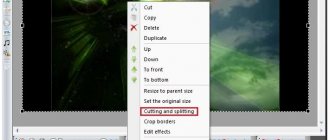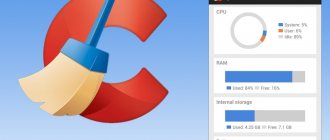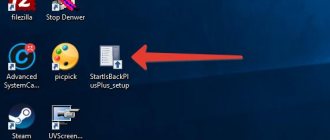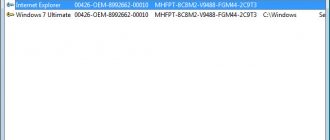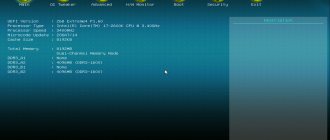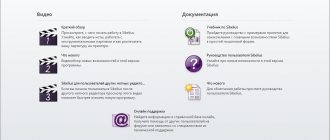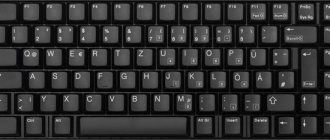Home » Knowledge Base
Category: Knowledge Base
- 1 CPU testing and overclocking
- 2 System Information Overview
- 3 Installing the utility
- 4 Advantages of Aida64
Aida64 EXTREME version is designed for home use and has all the necessary functions for both novice users and professionals. Synchronization with sensors on the motherboard allows the utility to provide information about the status of system components in real time. In this article we will begin to look at how to use the Aida64 program.
The user will be able to obtain complete information about the hardware and software of his computer. In addition, it is possible to test equipment, obtain data on the temperature of the main chip, and also manipulate processes running in cloud mode.
CPU testing and overclocking
Overclocking a processor is carried out to increase its performance. This is necessary to run demanding games or software. Testing is necessary to identify faulty parts of the motherboard. During the test, components are loaded above normal. In a critical situation, the test ends and the user is notified that there is a problem.
AIDA64 Extreme / Engineer 6.25.5400 in Russian + key
The use of the latest developments in the field of software and computer software qualitatively improves your work and provides great opportunities for business development. Every year new programs appear that expand the boundaries of the use of computer technology not only in offices, at home and in production.
One of these software products is AIDA64, which can provide complete and up-to-date information about how correctly your computer works:
- iron status;
- active network;
- correctness of connected devices;
- efficiency of the program;
- operating system productivity.
Free download AIDA64 Extreme/Engineer 6.25.5400 + keygen
Previous versions
AIDA64 Extreme/Engineer 6.10.5200
AIDA64 Extreme/Engineer 6.00.5100 Repack + Portable
AIDA64 Extreme/Engineer 6.00.5100
[collapse]
Password for all archives: 1progs
AIDA64 is today recognized as one of the most innovative, authoritative and popular programs in its subtype and shows the most reliable, timely information about certain and important components of the working system.
The main determinants of this software product are the latest tests for a complete and quick check of all operational qualities, efficiency, productivity, productivity, stability and correct operation of a personal computer.
AIDA64 also provides the most complete opportunity to monitor the present, current state of the entire operating system of the machine and fully displays the objective load being performed on the entire computer system.
AIDA64, for which we offer keys, is used for:
- identifying iron status;
- complete and up-to-date testing;
- high-quality monitoring of the current state of all used components in real time;
- will help determine the operation of the motherboard;
- assess the state of the working processor;
- will teach you how to quickly determine the parameters of a video card;
- will show all undocumented but present parameters of computer hardware;
- promptly tests and checks the entire computer;
- will also determine its reliability or stability;
- will tell you how to make the equipment work correctly.
Actually, AIDA64 is a reliable friend of any user, regardless of age, from a toddler to an experienced system administrator.
There are versions of this program for tablets and smartphones. This program is used for:
- computers;
- tablets;
- smartphones
- devices with Android system.
AIDA64, the activation of which is necessary on any computer device, is available in several versions:
- Engineer Edition is designed for commercial use;
- Extreme Edition is used by home users or computer enthusiasts who want to know everything about their iron friend;
- Network Audition Edition is for administration purposes only;
Business Edition was created to help all administrators of any corporate networks.
Attention! If Google Chrome blocks downloading a program, just copy the download link into a new window, the program should download normally.
Analogues of the program
See similar programs in our program selections
Iron
Programs for checking your computer
Programs for processor and video card temperatures
System Data Overview
The program provides a wide range of tabs to obtain information about equipment, configuration, programs and equipment status. The information is divided into sections and subsections for easy searching. Data in text and graphical form is provided for each internal hardware component. You can also find out the fan rotation speed and the heating temperature of the microcircuits.
Software
Aida 64 extreme provides comprehensive information about operating system parameters, installed software, license agreements, etc. As a result, visited web pages, active processes/services, startup programs, and DLL files are available for display.
If you are offered to download a cracked or hacked version of Aida64 extreme edition, we do not recommend downloading the utility this way. Since there is a high risk of your device becoming infected with a virus.
Advantages of Aida64
Among the main advantages it is worth highlighting the following:
- Cross-platform – the utility is available for installation on both computers and smartphones running OS from Microsoft and Apple;
- Low requirements for computer resources;
- The home version is distributed free of charge and in Russian;
- Ability to test equipment and receive detailed reports;
- A complete database of motherboard components and external devices;
- Ability to manage running processes;
- Ability to overclock the processor;
- Notifications in cloud mode even when the program is closed.
This utility should be installed on every user's computer. It will help you understand not only the structure of the motherboard, but also prevent problems on parts of the motherboard in time. Watch the video below, from which you will learn in more detail how to use the Aida64 program.
Athlon 64 3000+ review: AMD64 to the masses!
On the eve of the New Year, AMD presented its fans with an unexpected surprise. Quietly released processors of the Athlon 64 3000+ family began to appear on sale, costing just over $200. Thus, AMD has taken an important step, which could become the starting point for the mass introduction of processors with the AMD64 architecture into desktop computers. With the advent of inexpensive models of Athlon 64 processors, the line of 64-bit CPUs from AMD will undoubtedly gain much more popularity, which is by no means an unimportant factor in the conditions of severe competition with Intel, which is preparing to release new processors based on the Prescott core in the near future. Let's try to analyze how profitable the new offer from AMD - Athlon 64 3000+ is for users, and what market prospects this processor has. More about AMD Athlon 64 3000+
In anticipation of the appearance of the Athlon 64 3000+, almost everyone was sure that this processor would differ from the older Athlon 64 3200+ model only in clock speed. This confidence was based on the fact that the Desktop Replacement (DTR) AMD Athlon 64 3000+ processor, offered since the end of September for mobile solutions, has a frequency of 1.8 GHz and is no different from the DTR Athlon 64 3200+. However, AMD did something completely different: the new Athlon 64 3000+ for desktop computers has the exact same 2 GHz frequency as the Athlon 64 3200+. The difference between these models is the size of the second level cache. The L2 cache of the Athlon 64 3000+ is reduced to 512 KB versus the 1 MB cache of the Athlon 64 3200+. You can verify this, for example, by using any of the diagnostic utilities that determine the characteristics of the CPU:
As you can see, the differences in characteristics from the Athlon 64 3200+ are minimal. Apart from the halved L2 cache, the specifications of the new Athlon 64 3000+ are no different from those of the Athlon 64 3200+ released on September 23. Even the core stepping is the same. All this suggests that the Athlon 64 3000+ is based on the same semiconductor crystals as the older Athlon 64 models. AMD simply disables half of the second level cache in the Athlon 64 3000+, just as it was done in Athlon XP processors based on the Thorton core.
As a result, there are currently three Athlon 64 models on the market, which differ significantly (in the sense that not only in clock frequency) from each other:
| Athlon 64 FX-51 | Athlon 64 3200+ | Athlon 64 3000+ | |
| Packaging | Socket 940 | Socket 754 | Socket 754 |
| Frequency | 2.2 GHz | 2.0 GHz | 2.0 GHz |
| Production technology | 0.13 µm, SOI | 0.13 µm, SOI | 0.13 µm, SOI |
| Number of transistors | 105.9 million | 105.9 million | 105.9 million |
| Core area | 193 sq.mm | 193 sq.mm | 193 sq.mm |
| Rated voltage | 1.5V | 1.5V | 1.5V |
| Built-in memory controller | Dual channel, 128-bit | Single channel, 64-bit | Single channel, 64-bit |
| Supported memory types | Registered DDR400/ DDR333/ DDR266 SDRAM | DDR400/ DDR333/ DDR266 SDRAM | DDR400/ DDR333/ DDR266 SDRAM |
| ECC support | + | + | + |
| L1 cache | 128 KB (64 KB each for code and data) | 128 KB (64 KB each for code and data) | 128 KB (64 KB each for code and data) |
| L2 cache | 1024 KB (exclusive) | 1024 KB (exclusive) | 512 KB (exclusive) |
| Cool'n'Quiet technology support | — | + | + |
| Support for SIMD instructions | SSE2/SSE/3DNow! | SSE2/SSE/3DNow! | SSE2/SSE/3DNow! |
| AMD64 technology support | + | + | + |
The presence of a second level cache reduced to 512 KB in the Athlon 64 3000+ is confirmed by the markings of this processor:
announcements and advertising
2080 Super Gigabyte Gaming OC for 60 rubles.
Compeo.ru - the right comp store without any tricks
RTX 2060 becomes cheaper before the arrival of 3xxx
Ryzen 4000
series included in computers already in Citylink
The price of MSI RTX 2070 has collapsed after the announcement of RTX 3xxx
Core i9 10 series is half the price of the same 9 series
The price of memory has been halved in Regard - it’s more expensive everywhere
The number 4 in the third position from the end indicates that the L2 cache size of a processor with a rating of 3000+ is 512 KB. The Athlon 64 3200+ processor has the number 5 in this marking location.
The appearance of processors of the Athlon 64 family with a reduced second-level cache is quite understandable. There is no doubt that cheaper models in this family were necessary to intensify market capture. And then AMD faced the question: how to organize the production of cheaper Athlon 64 at the lowest cost. There is no doubt that processors of this family, which have a relatively larger core, have a fairly high cost. However, reducing the core, even by cutting the cache memory, will require investments in R&D (research and development), and therefore is beneficial only if it is necessary to produce extremely large volumes of processors. At the same time, again due to the large area of the Athlon 64 core, AMD produces a significant proportion of defective crystals that cannot be used in the Athlon 64 3200+. Since the L2 cache of the Athlon 64 3200+ occupies more than 50% of the core area, a significant part of the defects are dies with cache memory problems. It is quite logical that disabling half of the cache memory may allow such cores to be revived. Therefore, the release of the Athlon 64 3000+ with a 512 KB second-level cache is also a step that allows AMD to eliminate part of the defects, the share of which, due to the novelty of processor cores with the AMD64 architecture, is obviously very large.
As a result, the AMD Athlon 64 3000+ is a shot at two birds with one stone: users get inexpensive processors with AMD64 architecture, and the manufacturer gains the opportunity to profitably get rid of some of the defective crystals that cannot be used in more expensive CPUs.
Due to the fact that the Athlon 64 3000+ is made from the same crystals as the Athlon 64 3200+, all the characteristics of the Athlon 64 3000+ are the same as those of its older brother. This also applies to support for Cool'n'Quiet technology, which was discussed in detail in our review of the Athlon 64 3200+, and all thermal characteristics.
| Athlon 64 FX-51 | Athlon 64 3200+ | Athlon 64 3000+ | |
| Supply voltage | 1.5V | 1.5V | 1.5V |
| Typical Heat Dissipation (Cool'n'Quiet Off) | 89W | 89W | 89W |
According to AMD's current plans, Athlon 64 3000+ processors will remain the junior model in the family throughout the life of this line. That is, AMD does not plan to release CPUs of this family with a lower rating. As for the lifetime of the Athlon 64 3000+, AMD intends to continue releasing them until at least the third quarter of 2004. Thus, these CPUs will not disappear from sale quickly. However, the Athlon 64 3000+ will not be able to survive Socket A processors that will be produced until mid-2005.
Speaking about the prospects for processors with AMD64 architecture and a 512 KB L2 cache, you should refer to the official plans of AMD:
As you can see, these plans include the Newcastle core, which is characterized by a second-level cache memory trimmed to 512 KB. In this regard, many believed that the Athlon 64 3000+ was the first representative of the Newcastle line, however, this is not entirely true. The Newcastle core will be used in future Socket 939 Athlon 64 processors and, in addition to the 512 KB L2 cache, will feature a dual-channel memory controller. The idea behind the Newcastle release is to reduce the costs associated with the production of mass-produced AMD64 architecture processors by reducing the core area. The newly released Athlon 64 3000+ is intended for Socket 754 motherboards and has a single-channel memory controller. It is based on the Clawhammer core with half of the cache memory present on the chip, but disabled. Thus, to say that the Athlon 64 3000+ is the first processor with a new core is absolutely wrong. Apparently, the Athlon 64 3000+ will remain the only processor with a 512 KB L2 cache for Socket 754, at least for the next six months.
How we tested
The purpose of testing was to identify the level of performance of the new Athlon 64 3000+ in comparison with the performance of older processor models in the line, as well as in comparison with the speed of competing processors.
Our test systems used the following equipment:
- Processors: AMD Athlon 64 FX-51 (2.2 GHz);
- AMD Athlon 64 3200+ (2.0 GHz);
- AMD Athlon 64 3000+ (2.0 GHz);
- AMD Athlon XP 3200+ (2.2 GHz);
- Intel Pentium 4 3.2 GHz (800 MHz FSB);
- Pentium 4 Extreme Edition 3.2 GHz (800 MHz FSB).
- ASUS P4C800-E Deluxe (Socket 478, i875P);
- 1024 MB DDR400 SDRAM (Corsair CMX512-3200LLPRO, 2 x 512 MB, 2-3-2-6);
Notes:
- Memory (both non-register and registered) in all cases was operated in the same mode with timings 2-3-2-6;
- Testing was performed on the Windows XP SP1 operating system with DirectX 9.0b installed.
Overclocking
Before moving directly to the test results, we decided to talk about overclocking the Athlon 64 3000+ processor. The fact is that processors in this price category are often bought by overclockers who use them in an overclocked state. Therefore, it would be logical to add to the results of our tests the performance indicators obtained on an overclocked system using an Athlon 64 3000+. Let us immediately note that we carried out all experiments on overclocking the Athlon 64 3000+ without using extreme cooling methods. We used a regular cooler from the boxed Athlon 64 3000+.
First, about the overclocking characteristics of the processor. Since the Athlon 64 3000+ uses the same core as the Athlon 64 3200+, the new processor does not allow multiplier increases above the standard 10x, like its older brother. Lowering the multiplier is possible, but for overclocking this procedure is completely meaningless. Thus, the Athlon 64 3000+ will have to be overclocked at the FSB frequency. AMD, by the way, has been very clear about this: there will be no Athlon 64 processors with the ability to increase the multiplier above the standard one on the market. This feature will be present only in expensive Athlon 64 FX processors aimed at extreme users.
In passing, we note that we performed overclocking on the same motherboard as the main tests - on ABIT KV8-MAX3. Since this board is based on the VIA K8T800 logic set, when overclocked, the frequency on the PCI and AGP buses in this case increases simultaneously with the FSB. However, we were still forced to abandon the use of the more advanced NVIDIA nForce3 150 from this point of view. The NVIDIA logic set does not support Serial ATA and uses a “slow” HyperTransport bus, which leads to significantly lower performance in some modern games and professional applications. Therefore, today there is simply no point in using Socket 754 systems on the NVIDIA chipset.
However, the VIA K8T800 is not so bad for overclocking needs. Tests of motherboards based on nForce3 150 and VIA K8T800 show no differences in the actual results of overclocking performed on boards based on different logic sets. It is possible that with a significant increase in the FSB frequency, boards based on VIA K8T800 will cause problems for AGP and PCI devices, but when overclocking existing Athlon 64 processors on the C0 stepping core using air cooling, no such problems arise. We will be more quickly limited by the processor overclocking limit, which is at the level of 2.3-2.4 GHz, than by problems with the operation of external devices.
Since the Athlon 64 3000+ processors use exactly the same cores as the Athlon 64 3200+, we expected about the same overclocking results. Let me remind you that we managed to overclock the Athlon 64 3200+ to a frequency of 2.34 GHz. Accordingly, the maximum frequency of the Athlon 64 3000+, as we thought, would be approximately at the same level. However, practical tests showed a slightly different result.
Just before we talk about the success we have achieved in overclocking, it is necessary to note that for overclocking experiments we installed different memory into the system. The Corsair CMX512-3200LLPRO we use in regular tests works perfectly at the standard frequency at low timings. However, increasing the memory bus frequency leads to a noticeable deterioration in the stability of these modules. Therefore, in overclocking tests we used special overclocking memory OCZ PC4000 Dual Channel Gold Edition, which is guaranteed to operate at frequencies up to 500 MHz. Using this memory allowed us to overclock the Athlon 64 3000+ without increasing the memory frequency divider, which throughout all tests was set to 1/10 of the processor frequency (DDR400 in BIOS Setup terms).
To get better results when overclocking, we increased the processor supply voltage by 10% - to 1.65V and began to systematically increase the FSB frequency. The first problems were encountered when the FSB frequency reached 222 MHz. These problems resulted in the fact that the RAID array we were using refused to work. As it turned out, the controller built into the VIA VT8237 Serial ATA RAID southbridge reacts very sensitively to an increase in PCI frequency. With an FSB frequency of 222 MHz, the PCI frequency reached only 37 MHz, and this was already enough for the Serial ATA RAID controller to stop functioning stably. Therefore, we performed further overclocking using a Western Digital Caviar WD400JB Parallel ATA hard drive. Fortunately, the Parallel ATA controller in the VT8237, unlike the Serial ATA controller, behaves much more stable during overclocking.
However, replacing the disk subsystem did not give us much. Having reached the FSB frequency of 226 MHz, the system lost stability due to the processor. To be more confident in the stability of the results obtained, we rolled back to 1 MHz and conducted a full set of system stability tests. No problems were identified, so we can say that the final result of our overclocking is a processor frequency of 2250 MHz.
Let us recall that the supply voltage during overclocking was 1.65V, and the remaining system bus frequencies increased to the following values when the FSB frequency was increased to 225 MHz: memory – 450 MHz, PCI – 37.5 MHz, AGP – 75 MHz, HyperTransport – 900 MHz.
The result obtained can hardly be called good. We were able to increase the processor frequency by only 12% above the standard one, and besides, we were not able to reach the frequency we achieved when overclocking the Athlon 64 3200+, based on the same core. Apparently, this is the result of the fact that AMD selects defective crystals for the production of Athlon 64 3000+, which cannot be used for the production of more expensive processors. However, even a 10% increase in frequency is a result that you don’t want to neglect. As part of our test results, you will find figures characterizing the performance of a system built on an Athlon 64 3000+ processor, overclocked to 2.2 GHz by increasing the FSB frequency to 220 MHz. We considered it fair to fully test the overclocked platform precisely at a FSB frequency of 220 MHz for the reason that in this case all subsystems, including the Serial ATA controller, function normally. The memory in this case operated at a frequency of 440 MHz, timings were used - 2.5-3-3-6.
Performance: Gaming Applications
We paid special attention to testing the AMD Athlon 64 3200+ in games. The main consumers of AMD processors are enthusiast users, which include gamers in the first place.
The results that the Athlon 64 3000+ shows in gaming applications are quite good. Its lag behind the Athlon 64 3200+ with twice the amount of L2 cache is only 3-5%. The speed of the Athlon 64 3000+ looks good compared to the results of the Pentium 4. In about half of the tests in this class, the new CPU from AMD manages to surpass even the Pentium 4 3.2 GHz, and in traditionally “athlon-loving” games like Unreal Tournament 2003 or Tomb Raider Athlon 64 3000+ It turns out to overtake even the Pentium 4 Extreme Edition.
Overclocking the Athlon 64 3000+ to 2.2 GHz brings quite decent dividends and leads to an additional 7-8% increase in performance. This increase is contributed not only by the increased frequency of the CPU itself, but also by faster memory, HyperTransport and AGP during overclocking. Thanks to overclocking, the speed of the new CPU comes close to the performance of the Pentium 4 Extreme Edition, however, the overclocked newcomer still falls short of the results of the Athlon 64 FX-51 with a frequency of 2.2 GHz, a megabyte second-level cache and a dual-channel memory controller.
As for the performance ratio of the overclocked Athlon 64 with a reduced cache and a frequency of 2.2 GHz and the Athlon 64 3200+ with a full 1 MB L2 cache and a frequency of 2.0 GHz, then, as we see, the extra 200 MHz clock frequency makes a greater contribution to performance than cache increase by 512 KB. As a result, the Athlon 64 3000+ overclocked to 2.2 GHz outperforms the Athlon 64 3200+ operating at the standard 2 GHz frequency in all gaming tests.
Productivity: Office and digital content creation applications
Traditionally, in this section we present the results we obtained in test packages of the Winstone family. We have now switched to newer versions of these packages, released in late 2003: Business Winstone 2004 and Multimedia Content Creation Winstone 2004.
Business Winstone 2004 is a benchmark showing the weighted average performance of the platform when working in common office applications. The test simulates ordinary user work in common programs and produces results based on the time the programs take to complete the tasks assigned to them. The list of applications used in this benchmark to determine system performance is quite extensive and includes Microsoft Access 2002 SP-2, Microsoft Excel 2002 SP-2, Microsoft FrontPage 2002 SP-2, Microsoft Outlook 2002 SP-2, Microsoft PowerPoint 2002 SP-2 , Microsoft Project 2002, Microsoft Word 2002 SP-2, WinZip 8.1 SR-1 and Norton AntiVirus Professional Edition 2003.
Multimedia Content Creation Winstone 2004 is similar in principle to Business Winstone 2004, but the applications used by this test are different. All of them are intended for creating and processing images, audio and video streams. The full list of these programs includes popular and widely used products in professional work: Adobe Photoshop 7.0.1, Adobe Premiere 6.50, Macromedia Director MX 9.0, Macromedia Dreamweaver MX 6.1, Microsoft Windows Media Encoder 9 Version 9.00.00.2980, NewTek LightWave 3D 7.5 b and Steinberg WaveLab 4.0f.
In addition to the two aforementioned benchmarks, we decided to try using the new Futuremark PCMark04 test. This test also measures the speed of the system when performing common tasks. However, unlike Winstone packages, in addition to several popular programs, Futuremark programmers decided to add to their test and measure the speed of several commonly used algorithms from the applications in which they are used. Here is a list of tasks based on the speed of which the PCMark04 test makes a conclusion about system performance: archiving/unzipping using the ZIP algorithm, spell checking using Link Grammar Parsing Library, rendering web pages in Internet Explorer 6.0, converting images to JPEG format, mp3 encoding files using the library from Ogg Vorbis, video encoding using Windows Media encoder 9 and DivX 5.0.5 codecs, working with 2D graphic primitives, working in 3D via Microsoft DirectX 9 using the Havok Physics engine 2.1 physical modeling system, checking for viruses when using F-Secure Anti-Virus, encryption/decryption of information using Blowfish Algorithm.
In the Winstone family tests, the results of all Athlon 64 processors are quite impressive. For example, according to these tests, the Athlon 64 3000+ provides approximately the same level of performance as the Pentium 4 Extreme Edition 3.2 GHz. Another nice thing is that the difference in performance between the Athlon 64 3000+ and the Athlon 64 3200+ is no more than 2%.
The PCMark04 test, on the contrary, shows a crushing lag behind AMD processes from processors of the Pentium 4 family. To be honest, looking at such a clear lag of all Athlon 64 even from the Pentium 4 3.0 GHz, thoughts creep in about special optimization of this test for the Pentium 4 architecture. However, the results obtained easy to explain. Here are more detailed data on PCMark04 results for two processors – Pentium 4 3.2 and Athlon 64 3200+:
| Athlon 64 3200+ | Pentium 4 3.2 | |
| Multithreaded test 1 | ||
| File Compression | 2.7197 | 5.3799 |
| File Encryption | 31.269 | 49.375 |
| Multithreaded test 2 | ||
| File Decompression | 24.287 | 35.7 |
| Image Processing | 12.32 | 13.79 |
| Multithreaded test 3 | ||
| Virus Scanning | 2002.6 | 2619.9 |
| Grammar Check | 3.128 | 1.9596 |
| Singlethreaded tests | ||
| File Decryption | 62.056 | 81.82 |
| Audio Conversion | 2658.2 | 2650 |
| Web Page Rendering | 5.167 | 6.0498 |
| WMV Video Compression | 48.165 | 52.211 |
| DivX Video Compression | 58.764 | 60.842 |
| Physics Calculation and 3D | 181.38 | 170.58 |
| Graphics Memory - 64 Lines | 2697.7 | 2636.2 |
The Athlon 64's lag in the first six subtests is due to its multi-threaded structure. Here PCMark04 runs two computational threads synchronously. In these conditions, the Pentium 4 naturally comes out on top, thanks to Hyper-Threading technology, which allows two threads to run simultaneously.
As for the second part of the subtests, the tasks that predominate among them relate to streaming data encoding, and when working in such applications, the Pentium 4 is really faster. The Athlon 64's gains in physical modeling and grammar checking are clearly not enough to compensate for the Pentium 4's superiority in other subtests.
Thus, PCMark04 is a fair test in the sense that it does not use any special optimizations for the Pentium 4. However, in general its structure is such that the Pentium 4 will reasonably show a higher result in the end. This is the result (consciously or not - it is not clear) of the choice made and the sequence of tasks performed in PCMark04.
Performance: Data Encoding and Compression Applications
r
In tasks of this class, a significant impact of the size of the second level cache on performance can be noticed only when compressing information in both archivers we used. In other cases, the speeds of the Athlon 64 3200+ and Athlon 64 3000+ do not differ much: the magnitude of this difference is within one percent. As for the performance of the Athlon 64 3000+ in general, it turns out to be quite decent when archiving/unzipping information, as well as when encoding a video stream into the MPEG2 format. As for other tasks, such as mp3 encoding, encoding WME and MPEG4 files, Pentium 4 processors are traditionally much stronger in them. Moreover, neither overclocking the Athlon 64 3000+ to 2.2 GHz nor using a dual-channel memory controller in the Athlon 64 FX-51 processor helps to correct this situation.
Performance: Professional Applications
Final rendering in 3D modeling packages is not a task that the Athlon 64 family processors handle well. The Pentium 4 performs this process much more efficiently thanks to its support for Hyper-Threading technology. As for OpenGL tests, the newcomer from AMD is very strong in them, and is not inferior to the Pentium 4 3.2 GHz.
conclusions
Let's look at the price list. The official price of AMD Athlon 64 3000+ processors is $218. This means that this processor is positioned by AMD as a competitor to the Pentium 4 2.8 GHz, which has the same price in Intel's official price list. However, as we saw from the test results, the Athlon 64 3000+ is capable of outperforming even faster processors from Intel in most tasks. Similarly, we can say that the Athlon 64 3000+ is faster than the Athlon XP 3200+. Thus, this clearly indicates that in its price category, if you do not take into account overclocking, the Athlon 64 3000+ is one of the most profitable processors today in terms of price-performance. Of course, one can complain a little about the weak overclocking that the Athlon 64 3000+ processors are capable of. However, the performance of these CPUs is quite high even without overclocking, and a possible 10% increase in frequency above the standard one still gives a chance to get an additional 7-8% speed.
In addition, some questions are raised by the prospects for upgrading Socket 754 processors, which include the Athlon 64 3000+. Indeed, the older CPU model installed in this socket will be the Athlon 64 3700+, and this may raise some doubts that the Athlon 64 3000+ is currently the most profitable purchase in its price category. However, any other processor sockets today also have rather limited prospects for future upgrades. Socket 478 will soon be replaced by Socket T, new processors for Socket A will not be released at all, and Socket 940 will be replaced by Socket 939 in the foreseeable future. Thus, this objection also has no real basis.
As a result, there is no longer any doubt that the Athlon 64 3000+ today is the best choice in the category of processors with a price of about $200, if you do not take into account the possibility of overclocking. And given that this price category is the most popular among users who assemble their own computers (see, for example, the survey results here ), we can say that AMD’s move with the release of the Athlon 64 3000+ can greatly affect the distribution and popularity AMD64 architecture in general. The main problem that AMD may now face is the inability to provide everyone with its extremely profitable CPUs.
Well, in conclusion, I would like to note that, as we have seen, cutting the Athlon 64 cache in half does not lead to a significant drop in performance. The differences in performance of the Athlon 64 3200+ and Athlon 64 3000+, operating at the same clock speed but differing in the size of the L2 cache, in most cases do not exceed 5%. This suggests that future processors based on the Newcastle core will be able to solve the task assigned to them. While maintaining the level of performance we expect from Athlon 64 processors, this new core will allow AMD to reduce manufacturing costs and increase profitability.
Screen monitoring, notification in AIDA64 Extreme
Sensor readings can be displayed both on the taskbar in the icon area, and on the OSD screen, touch panel, screens of “gaming” keyboards Razer and Logitech, and the side panel of the gadget. Moreover, readings can be recorded to a file or “transferred” to external applications such as Samurai or RivaTuner. In addition, it is possible to send a message from Aida64 to the user when a critical temperature is reached or the fan breaks down.
AIDA64 Extreme was developed to allow full diagnostics and testing of a personal computer at home. Therefore, the application has great potential for improving performance. You can download AIDA64 Extreme for free on our website below.
Moreover, the program can collect information about all devices and parts of the computer. It will help in identifying errors and testing the system. The utility will promptly warn the user about the occurrence of a malfunction or any technical problems. The program has the ability to determine the performance level of RAM, processor and hard drive.
Among other things, the program contains a variety of tests. They calculate the speed of calculations and information processing tasks. The AIDA64 Extreme Edition application can work without any problems with any operating system without exception.
Articles and books by site guestsL. Konovalov How Hollywood “flew” to the moon (09.29.20)
L.Konovalov How to depict in a photograph that an astronaut on the Moon weighs little? (31.08.20)
L. Konovalov Why did the “myth busters” resort to falsification? (31.08.20)
L. Konovalov Irrefutable evidence of Americans being on the Moon (04/29/20)
L. Konovalov Mythbusters tried to prove that the Americans were on the Moon, but the result was the opposite (04/29/20)
L. Konovalov All long-range plans and landscapes on the Moon were filmed using puppets and models (04/26/20)
N.G. Ivanov. The influence of the Moon on the human mind (Judgment to the lunar rover, part 3) (04/26/20)
N.G. Ivanov. Sentence to the lunar rover, part 2 (04/17/20)
L. Konovalov NASA presented puppet films as evidence of being on the Moon (04/17/20)
N.G. Ivanov. Sentence to the lunar rover, part 1 (4.04.20)
L. Konovalov What you don’t know at all about the “lunar” Hasselblads (30.03.20)
L.Konovalov The most famous lunar shots were shot using... dolls (03/23/20)
L.Konovalov What lens was used to film Armstrong's walk to the moon in the pavilion? (15.03.20)
L. Konovalov Who went down the stairs instead of Armstrong? (22.02.20)
N.G. Ivanov. The key to the Apollo 15 scam (02/18/20)
N.G. Ivanov. LRO images and traces on the Moon (11/22/19)
N.G. Ivanov. Lunar rover - Grand Prix or Grand Fake? (22.11.19)
BigPhil. News of the real history of space exploration - D. Young - the first real American astronaut (02/1/20)
A. Lavritov. Moon scam. Why was the USSR silent? (12/18/19)
V.Telezhko
“American flights to the Moon - Big Fake USA” - the Americans had neither a rocket engine, nor a rocket, nor a ship for flights to the Moon (17.1.18)
F. Kuts
“The Apollo Myth as an obstacle to the development of manned astronautics” - the history of the Apollos is increasingly being revealed as pure fiction (11/22/17)
O. Polivanov
“The lunar point of Egorov’s green cat” is about LROC allegedly “proving” the presence of astronauts on the Moon. Read more about the resolution of LRO in the article by I. Averin “Does lying affect vision”?
(10.03.17) A. Kudryavets
“On the issue of photographs of the Apollo missions on the Moon” (10.3.17)
F. Kuts
“Towards the creation of a lunar base: leaving the Apollo legacy behind” - data on radiation doses (2.11.16)
A. Kudryavets
“On the color of the Moon” (8.2.2016)
A. Velurov
“The Great Carburetor (a brief summary of the article)” - about the F -1 engine (12.08.15)
A. Kudryavets
“On the prose of life in the Apollo missions” (29.6.15)
F. Coots
“Is there anything to take from the Apollo legacy?”
(26.5.15) F. Kuts
“Is there any hope of finally building a lunar base?”
(28.8.14) S.M.Eremenko
“To the Moon with God’s help...” (12.1.15)
G.G.Ivchenkov
“Review of A.Velyurov’s article “The Great Carburetor”” (14.1.14)
G.G.Ivchenkov
“Evaluation of the characteristics of F-1, based on the analysis of heat transfer and strength of the tubular cooling jacket” (11/26/13)
A. Onoprienko
“Lunar mega-production” (09/01/10)
Contemplator. Contact comic SF story (25.2.12)
N.V. Lebedev . From the memories of a rocket scientist. (02.01.13)
S.G. Pokrovsky
Lunar soil - the possibility of passing off meteorites as lunar soil (25.5.10)
Interface and functionality overview
In this matter, the good old AIDA (formerly Everest) will help us, which I already wrote about in the article “System in Section” or “What’s What on the Computer.” Part 1. [AIDA].
Launch and select in the “Tools” program window – “System stability test”.
In fact, we see the following:
The top graph shows the temperatures of the computer components. By checking or unchecking the checkbox, you can enable or disable the display of the temperature of any component on the graph. Accordingly, if you know for sure that your hard drive does not overheat during work, then simply uncheck it so as not to clutter the graph with unnecessary information. There, above the first graph, you can switch between tabs that display other information (cooler rotation speed, voltage, etc.). The most valuable tab there is the last one, because on it, in a visual table (where the minimum and maximum of any parameter are written down), all statistics (temperatures, voltages, etc.) collected during testing are indicated.
The bottom graph shows the processor load (Cpu Usage) and the clock skipping mode (Cpu Throttling). A few words about CPU Throttling. This is a technology that, in the event of overheating of the processor, activates the so-called skipping of clock cycles, which greatly reduces performance and, therefore, temperature, which often saves you from emergency shutdown of the computer and loss of information. But, as you understand, if this mode starts, it means the temperature has reached a critical mass and, it is extremely important to turn off the computer and figure out what the problem is with the cooling system.
The types of tests are indicated at the top: Stress CPU, Stress FPU, Stress cashe, Stress system memory, Stress local disks (processor, cooler, cache, RAM, hard drives). The word Stress means that one or another system component, marked with a checkmark, will be subject to a load of one type or another, ranging from a simple simulation of operation (for example, the processor calculating some complex operation) and ending with emergency situations (such as a decrease in the speed of coolers , which simulates, say, summer heat).
